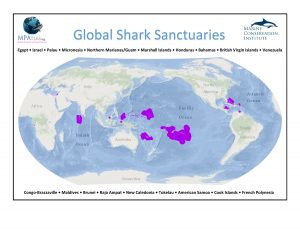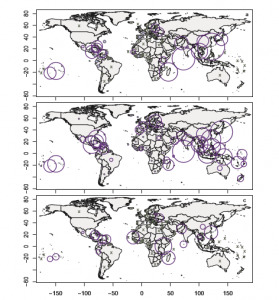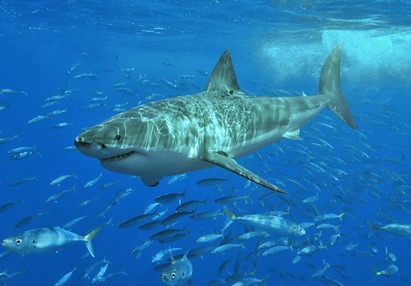
The Human- Shark Connection
As Shark Week draws to a close, people around the world are reminded of their deep fascination with sharks and human interactions. However, while Shark Week tends to focus on sharks as apex predators, we must consider another type of shark-human interaction- the kind where we as humans are the apex predator, not the sharks.
Many species of sharks are listed as vulnerable, threatened, endangered, or critically endangered according to the IUCN red lists for endangered species, with population declines of 90-99% since the 1950s for some species. This massive decrease has been largely caused by the fishing of sharks for their fins, skins, liver oils, teeth, and meat, which has been reported to be a loss of about 100 million sharks every year! However, in addition to targeting sharks for these goods, many times sharks are caught by accident when targeting other species. This accidental capture is called bycatch.
Depending on the catch, bycatch is sometimes released back into the wild, dead or alive, or “landed” and sold for profit. Sometimes bycatch is reported; however, many times, bycatch is not reported in any fishing logs or landings data. This is either because the fishermen released it, are under-reporting their catch, or fishing illegally. This prevents scientists from getting an accurate number of sharks being caught and therefore affects the management strategies to conserve these populations.
Conservation Policies
But what type of management strategies exist for shark conservation around the world? There are laws that require sharks to be landed in port with their fins naturally attached to prevent a process called “shark finning” (where fins are sliced off the sharks and the carcass thrown overboard to maximize space on the boat). There are fishery management regulations such as permits assigned to specific fishermen to reduce catch “effort” (number of fishermen/boats), quotas on the number of sharks that can be caught, and gear restrictions such as banning the use of long-line fishing gear used to catch hundreds of sharks at a time. There are also bans on fishing/trade such as species-specific bans for endangered species, and bans on the possession, sale, trade, export, transport, and processing of shark products. There are also marine protected areas, which can have many different categories of protection.
One type of shark conservation measure is the establishment of marine protected areas called Shark Sanctuaries, where shark fishing is forbidden in a country’s waters out to 200 miles within the economic exclusive zone. Think of it like a safe zone for sharks to swim wherever they want without the risk of being caught! This strategy has been implemented in 24 countries since 2009, a great advancement for the conservation of these species. But while Shark Sanctuaries are a great concept, very little is known about whether or not this type of strategy is successful in the conservation of sharks.

The Study
Dr. Ward-Paige from Dalhousie University in Nova Scotia, Canada compared the impact of Sanctuaries on the fishing industry by using landings data since the 1950s. Her results indicated that while 3% of the world’s oceans are protected from shark fishing, these regions only historically accounted for <1% of the global total shark catch (7,515 tonnes in Shark Sanctuaries vs. 1,445,000 tonnes globally); therefore, while these shark sanctuaries do great things for sharks in those countries, more needs to be done to conserve these species in the top shark fishing countries of the world. Countries such as Indonesia, India, Taiwan, Argentina, Mexico, Pakistan, Malaysia, Japan, France, Thailand, Brazil, and even the United States- rank among the 13 shark fishing countries in the world and all of which are also known to travel to and fish within shark sanctuary waters.

She also found major loopholes in many of the Shark Sanctuary legislation, which gives these fishermen ample opportunities to bypass the system and illegally fish within these protected waters. In addition to loopholes, she also found that these regulations primarily focused on commercial shark fisheries in particular, which accounts for only about 84% of the shark fishing in these countries, the remainder being small-scale and subsistence fishing. However, that is still 84% of the shark population protected!
Most of the shark sanctuary regulations lacked specifics on what to do in the case of bycatch reporting, though many of them require that sharks be released unharmed or with the best chance of survival. This finding brings to light an area of management which needs improvement to account for the number of sharks being caught through bycatch and released, whether these sharks survive or not. Unfortunately, the mortality rate of sharks caught as bycatch is significantly higher than that of survival, which contributes to the need of reporting these numbers for management purposes. If more sharks are being killed than previously reported, this makes their need for conservation all the more vital.

This research also concluded that the effective management of these Shark Sanctuaries requires an evaluation of the progress being made toward the conservation of these species as well as stated goals and objectives to achieve these results. This evaluation can be done through scientific research, analyzing catch data, stakeholder involvement, and effective enforcement of the regulations. However, adequate evaluation of a shark sanctuary requires baseline data to compare results and funding for implementation, enforcement, and evaluation.
How do we use this info for the future?
Shark conservation policies depend heavily on a number of biological, as well as socioeconomic, factors that determine how successful it will be at achieving the intended purpose. While there are improvements that could be made to current sanctuaries and other policies, these conservation measures are better than none at all! Evidence has shown that these policies have been successful in reducing shark mortality; however, more efforts need to focus on bycatch mortality and illegal fishing. We as scientists and policy-makers can use this information in the establishment of future conservation measures. Without conservation, we will lose these extremely important creatures which regulate ocean ecosystems from the top-down, and will ultimately affect not only the health of the oceans, but our food supply as well… and also, without Sharks, there will be no more Shark Week… and that would not be a world we want to live in!
Amanda Ingram is a Masters of Marine Affairs Graduate Student at the University of Rhode Island. She earned her double Bachelors degrees in 2010 at California Lutheran University with a B.S. Environmental Science with emphasis in Marine Science, and B.A. Communications. After graduation, she spent 7 years as an Environmental Policy Consultant before returning to graduate school for Marine Policy. Her current research focuses on the socio-economic and social perspectives of shark conservation measures. When she is not out telling everyone how JAWESOME Sharks are, she is playing with her 7 month old son,… usually with toy sharks.


